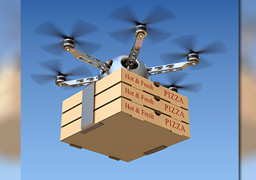




 |
 |
 |
|||
 |
 |
 |
 |
 | |
 |
 |
 | |


| 글로벌 트렌드 | 내서재담기 |


  |
 |  |
불과 수년 전만 하더라도, 드론은 독특한 틈새 상품 혹은 장난기 많은 10대들을 겨냥한 장난감처럼 취급됐다. 그러나 현재 폭넓은 적용 범위와 상업적 유용성으로 인해 드론의 위상은 급속히 높아졌고, 각종 현안에 대한 해결책으로 떠오르고 있다. 이렇게 세계에 엄청난 여파를 몰고 올 드론 앞에 놓인 장애물은 무엇인가? 또 개인과 비즈니스, 투자자와 정부의 입장에서 드론 붐은 각각 어떤 의미를 가지는 것일까?
드론은 우리의 생활에 일대 혁명을 불러일으킬 것이다. 자동주행 자동차처럼 드론도 ‘서비스 로봇’의 일종이라고 할 수 있다. 어떻게 보면 우리 삶을 바꿔 놓을 수 있을 정도의 파급력을 가진 최초의 서비스 로봇이라고 해도 과언이 아니다.
최근 10년 동안 드론의 폭발적인 진화는 마치 지구의 진화 과정에서 나타난 ‘캄브리아 폭발Cambrian Explosion(약 5억 4200만 년 전부터 5억 3000만 년 전 사이에 갑자기 현재의 생물 체제가 등장한 현상)’을 연상시킬 정도다. 몸체는 더 작아지면서 영향력은 더 커지는 일이 동시에 발생하고 있는 것이다. 뿐만 아니라 신뢰성과 기능, 속도와 강력함, 지능과 안전성, 가격과 실용성 등 모든 측면에서 한층 향상된 드론으로 진화해 가고 있다.
현재의 드론은 문화와 산업의 다층적인 발전 과정에서 발생한 상호작용의 결과물이다. 먼저 등장한 것이 주로 군사적 사용을 목적으로 한 무인 비행체UAVs로, 대규모의 예산을 들여 최첨단 사양의 소량 생산으로 진행됐다. 2차적으로는 어린이와 애호가들을 겨냥한 원격조정 장난감 형태의 드론이 등장했는데, 투입된 예산은 상대적으로 적지만 사양을 낮추면서 대량으로 생산할 수 있다는 장점을 가졌다. 이런 역동성은 또한 컴퓨팅, 센서, 스마트폰, GPS, 전기 모터, 네트워킹, 배터리 등 드론의 부속 기기들과 관련된 분야가 급속하게 발전하는 배경 역할을 하기도 했다. 이처럼 여러 분야에 걸친 다양한 발전 과정을 통해, 드론은 수많은 신규 응용 분야에서 만족할 만한 기능과 역량을 갖추게 되었다. 기존의 산업을 해체할 뿐 아니라 완전히 새로운 산업을 창조할 만한 그야말로 ‘혁신적 기술’의 본보기라고 할 수 있다.
2016년 1월을 기준으로 보자면 약 18만 1,000대의 드론이 미국 연방항공국에 등록되어 있다. 관련 미국 연방법이 2014년 완화되면서, 무인 비행체에 대한 특별허가가 가능해졌다. 하지만 전문가들은 드론 산업에 있어 가장 큰 장애물은 여전히 당국의 규제라고 입을 모은다. 미국의 항공로 전반을 관할하는 연방항공국은 상업용 드론의 사용과 운송에 관한 명확한 규칙 제정에 대체로 미온적인 태도를 보여 왔다. 이런 이유로 2015년 초반만 하더라도 미국에서 상업적으로 드론 운용을 허가받은 업체는 불과 10여 곳에 불과했다. 이후로 무인비행 시스템 업계와 연방항공국은 승인 절차를 간소화하기 위해 공조해 왔다. 당국은 또한 상업용 드론 규제조항 일부를 완화해 기업들이 상업용 드론을 보다 유연하게 사용할 수 있도록 돕고자 했다.
이런 노력들 덕에 많은 업체들이 비행을 허가받을 수 있는 특별 예외조항이 탄생했고, 또한 드론에 탑재할 수 있는 기기들도 다양화되어 2015년 말에는 1,000곳 이상의 기업들이 비행 승인을 받을 수 있었다. 국제무인기협회가 연방항공국이 발행한 최초 500건의 상업용 드론 허가서를 조사한 결과, 이 예외조항이 48개 주에 걸쳐 20개 주요 산업으로 확대되었다는 사실이 밝혀졌다.
앞으로 드론의 미래는 어떻게 될까?
첫째, 군용 드론 시장은 이후 10년 동안 계속해서 미국이 주도할 것이다.
그 이유는 대개 군용 드론이 상당히 고가인데다가 적용 분야도 매우 명확하기 때문이다. 미사일을 장착한 군용 드론은 오랜 시간 공중을 비행하고 개인을 정확하게 조준할 수 있는 능력 때문에 테러리스트 공격용 무기로 선호되어 왔다. 더 중요한 점은, 미 해군이 스텔스 기능을 갖춘 함상 탑재용 드론의 개발에 적극적이라는 사실이다. 이를 이용하면 어느 군함이든 사실상 항공모함의 기능을 할 수 있기 때문이다. 다른 한편으로는 벌새처럼 작아 탐지가 어렵고 정보 수집에 이상적인 소형 드론의 연구 개발도 추진되고 있다. 많은 동맹국이 미국의 시스템을 구입할 것이지만, 그 외의 국가들도 각자 이런 기술을 모방하는 일에 급히 착수할 것으로 보인다.
둘째, 앞으로 10년 동안 드론은 국방 분야뿐 아니라 다른 공공 분야에서도 커다란 비중을 차지할 것이다.
상공을 비행하고 활동을 감시할 수 있는 기능은 법 집행, 야생동물 관찰, 환경 보호, 수색 및 구조 활동 등의 분야에 특히 유용하게 쓰일 수 있다.
셋째, 상업용 드론의 활성화에 대처하기 위해, 미국의 항공교통관제 시스템이 빠르게 확대될 것이다.
본래 드론이 주로 비행하는 저고도 공역은 비행하는 항공기도 거의 없고 비행 속도도 느리다는 이유로 규제 대상에서 제외되어 왔다. NASA의 무인항공교통관리 프로젝트는 드론의 폭발적인 증가에 발 맞춰 드론 항공교통관제 시스템 개발에 열을 올리고 있다. 무인 항공기의 비행 패턴에 영향을 미칠 수 있는 기상 상태, 항공교통 밀집 현상, 지형, 건물 등의 중요한 정보를 입수하여 안전하게 저고도 비행을 할 수 있게 하기 위함이다. 이 시스템의 핵심은 NASA가 네바다 대학교와 공동 개발하고 있는 소프트웨어가 될 것이다. 이 소프트웨어는 드론과 기존 항공교통 기반시설을 연계해 주는 역할을 할 예정이다. 드론 항공교통관제 시스템을 개발하기 위해 NASA는 스카이워드Skyward라는 소프트웨어 기업과도 제휴하고 있다.
넷째, 미국은 자신이 개척한 드론 산업에서 앞으로도 전 세계를 이끄는 역할을 하겠지만, 우선 관련 규제부터 적극적으로 쇄신해야 할 것이다.
최근 개정된 새 규정들이 이미 과거에 비해 개선된 모습을 보이고 있어 드론 규제에 있어 기업 친화적인 현재의 여러 EU 국가들과 비슷한 수준이 될 것으로 예측된다. 연방항공국은 관련 업계와 함께 가시선可視線 규제와 같은 까다로운 분야에 대해 연구를 계속하고 있다. 하지만 충돌 예방을 위한 감지 및 회피 같은 기술처럼 기업들이 고안해야 하는 복잡한 시스템은 향후 2년 정도 동안 캐나다, 프랑스, 호주 등에서 더욱 수월하게 개발될 것이다. 특히나 다른 나라들이 현재 수준에서 가만히 정체되어 있지 않을 것이란 점이 중요하다. 앞으로도 이들 국가의 규제는 새로운 미국의 규정보다도 변화된 기술 환경에 잘 대처하고 있을 가능성이 높다.
다섯째, 향후 10년 내에 농업은 드론 및 관련 서비스의 주요 소비처가 될 것이다.
현재는 일본이 이 농업 응용 분야에서 선도적인 위치를 차지하고 있지만, 미국도 관련 기술에 이미 익숙한 상태다. 농업용 드론은 농약 살포, 가축 모니터링, 농작물 관찰 등 다양한 작업을 능숙하게 소화할 수 있다. <보스턴 글로브>에 따르면 드론의 효율성이 미국 농업 분야에 미칠 영향은 막대할 것이라고 한다. 수십 억 달러에 달하는 경제 수익과 수많은 일자리 창출이 기대되고 있다. 미국 농업협회의 연구결과는, 농부의 투자수익률만 해도 옥수수는 에이커 당 12달러, 콩과 밀은 에이커 당 2~3달러로 상승할 것이라 예측하고 있다(1에이커=약 4,046제곱미터). 이런 이유로 일부 전문가들은 2050년에 이르면 소위 애그드론AgDrones이라 불리는 농업용 드론이 전체 상업용 드론의 약 80%를 차지할 것이라고 전망하고 있다.
여섯째, 미국 외 지역에서 우선 좋은 출발을 보인 드론 운송 서비스는 2020년이면 미국에서도 말 그대로 날아오를 것이다.
일반 소비자도 직접 경험할 수 있는 택배 서비스가 가장 대중화된 상업적 응용 분야라고 할 수 있다. 아마존의 드론 배송 서비스 ‘아마존 프라임 에어Amazon Prime Air’을 보라. 2015년 11월, 아마존은 30분 내에 고객에게 배송 물품을 전달할 수 있는 상당히 근사한 시험용 드론을 선보였다. 하지만 “과연 30분 내 배송 서비스를 위해 소비자들이 얼마나 더 비용을 부담해야 할 것인가?”란 의문이 제기된다. 다행인 것은 ARK 인베스트 사의 애널리스트 타샤 키니Tasha Keeney의 최근 보고서에 따르면, 프라임 에어 서비스 한 건 당 드는 아마존의 비용이 단지 88센트에 불과하다는 것이다. 이에 대해 아마존이 고객에게 건당 1달러의 요금을 부과한다면, 현재보다 더 저렴한 당일 배송 서비스를 유지하면서도 드론 기반시설에 대한 투자수익을 50%나 거둬들일 수 있다고 키니는 예상한다. 키니의 보고서는 연 평균 5만 달러의 매출을 내는 6,000명의 조종사가 총 3~4만 대의 드론을 운영할 것이며 또 각각의 드론이 매일 30건의 배송을 맡는다는 전제 아래 작성된 것이다. 이외에도 전력, 보조 배터리, 주파수 대역폭, 시설 업그레이드 등의 비용도 포함시켰다.
일곱째, 2025년이 되면 상업용 드론 기술이 통근용 항공 택시 시장을 흡수하여 완전히 새로운 수십 억 달러 규모의 산업을 탄생시킬 것이다.
이 개념을 현실에서 구현한 ‘이항 184EHang 184’라는 기기가 2015년 말 첫 선을 보였다. 좌석이 하나인 이 비행체는 시속 약 60마일의 속도로 평균 10마일 내외를 주행하려는 목적으로 설계됐다. 이항이 독자적으로 개발한 안전 시스템은, 만약 기기가 오작동을 일으키거나 비행 중 기체가 손상되면 착륙 등 승객의 안전을 위한 조치를 즉각 실시하도록 고안되었다.
마지막으로, 대부분의 회사는 직접 드론을 구입하기보다는 외부의 드론 서비스 공급자들과 계약을 체결해 운영할 것이다.
드론 산업의 여러 특성상 규모의 경제, 지역적 경제가 될 것이므로, 드론 기반 솔루션을 통해 경로 설정, 모니터링, 배송 등을 관리할 제3의 전문 기업을 고용할 만한 충분한 이유가 있다. 이 분야에 뛰어든 신생 스타트업 기업으로 플라이포미Fly4Me, 메저Measure, 고포Gofor, 스카이캐치Skycatch, 워크모드Workmode 등이 있다.
* *
References List :
1. Reuters, January 6, 2016, “FAA Says 181,000 U.S. Drones Registered in Its Database.” ⓒ 2016 Thomson Reuters. All rights reserved.
http://www.reuters.com/article/us-usa-drones-registration-idUSKBN0UK2MC20160106
2. Fortune, August 9, 2015, “FAA Approves More than 1,000 Commercial Drone Permits,” by Clay Dillow. ⓒ 2015 Time, Inc. All rights reserved.
http://fortune.com/2015/08/09/faa-commercial-drone-permits/
3. Popular Science, May 29, 2015, “Special Forces Test Hummingbird-Size Drone,” by Kelsey D. Atherton. ⓒ 2015 Popular Science, a Bonnier Corporation Company. All rights reserved.
http://www.popsci.com/american-special-forces-test-hummingbird-sized-drone
4. Fortune, August 7, 2015, “NASA’s Drone Air Traffic Management Project Just Got a Software Boost,” by Jonathan Vanian. ⓒ 2015 Time, Inc. All rights reserved.
http://fortune.com/2015/08/07/nasa-drone-air-traffic-management-project-software/
5. The Boston Globe, August 22, 2015, “Agricultural Drones May Change the Way We Farm,” by John Wihbey. ⓒ 2015 Boston Globe Media Partners, LLC. All rights reserved.
https://www.bostonglobe.com/ideas/2015/08/22/agricultural-drones-change-way-farm/WTpOWMV9j4C7kchvbmPr4J/story.html
6. Daily Mail, January 6, 2016, “The MEGADRONE Big Enough to Carry a Passenger,” by Ellie Zolfagharifard. ⓒ 2016 Associated Newspapers Ltd. All rights reserved.
http://www.dailymail.co.uk/sciencetech/article-3387542/The-MEGADRONE-big-carry-passenger-Chinese-firm-says-self-flying-craft-used-smart-taxi.html
 |  |
The Drone Revolution Is Coming
Drones are about to revolutionize our lives.
Among the twelve breakthrough technologies of the Fifth Techno-Economic Revolution, drones (like self-driving automobiles) fall into the category we call “service robots.” And they are likely to be among the first types of service robots to go mainstream.
The explosive evolution of drones during the current decade is reminiscent of nature’s Cambrian Explosion. They are simultaneously getting both bigger and smaller. At the same time, they are becoming more reliable and more capable; faster and more powerful; smarter and safer; cheaper and more practical.
Today’s drones are the result of the interaction of multiple sets of development cultures and industrial processes. The first industry created unmanned aerial vehicles (UAVs) targeted mostly at military applications; they required big budgets, cutting-edge specs, and small unit volumes. The second industry makes remote-controlled toys targeting children and hobbyists; this industry must cope with low budgets, but enjoys the advantages of flexible specs and huge volumes.
These dynamic industries both piggy-backed on rapid advances in computing, sensors, smartphones, GPS, electric motors, networking, and batteries that were developed for other applications. Through this cross-disciplinary fertilization process, drones have acquired the features and capabilities that suddenly make them “good enough” for many new applications.
This is the very definition of a disruptive technology - and these drones have the potential to create whole new industries, as well as disrupting existing ones.
Currently, there are about 181,000 drones registered with the Federal Aviation Administration.1 Federal rules around unmanned aerial vehicles were loosened in 2014, enabling the granting of special permits. However, experts say the biggest hurdle is still regulation - the FAA, which oversees American airspace, has been slow to establish clear-cut rules regarding commercial drone use and delivery.
That’s why, as recently as the beginning of 2015, only a dozen companies were approved to operate drones commercially in the U.S. Since then, the unmanned aircraft systems industry and the FAA have worked to streamline the approval process. The agency has also loosened certain aspects of its commercial drone regulations to give approved companies greater flexibility in how they use commercial drones.
Those efforts have driven a drastic uptick in the number of companies approved to fly under so-called “Section 333 exemptions,” as well as a broadening of the applications for which these drones are employed, with over 1,000 companies approved as of year-end 2015.2
The Association for Unmanned Vehicle Systems International recently examined the first 500 commercial drone permits issued by the FAA and found that exemptions spanned 20 major industries across 48 states.
Given this trend, we offer the following forecasts for your consideration:
First, the military drone market will continue to dominate in dollar terms over the coming decade.
That’s largely because military drones tend to be very expensive and their applications are well defined. Missile-equipped military drones have become the “weapon of choice” against terrorist networks due to their ability to linger and precisely target individuals. Even more importantly, the U.S. Navy has pioneered a range of stealthy, ship-based drones designed to transform almost any navy ship into a de-facto aircraft carrier. At the other end of the spectrum, researchers are developing tiny drones the size of hummingbirds that are nearly undetectable and ideal for gathering intelligence.3 While many allies will purchase U.S. systems, other nations will rapidly work to emulate these capabilities.
Second, in addition to defense applications, other public-sector applications will play a big role in driving drone spending over the coming decade.
The ability of drones to linger over areas and observe activity is particularly useful in applications like law enforcement, wildlife monitoring, environmental monitoring, and search and rescue.
Third, to accommodate the coming flood of commercial drones, America’s air traffic control (ATC) system will be rapidly expanded.
Traditionally, the low altitude airspace in which drones mostly operate has been “uncontrolled” because of the few aircraft and low speeds involved. NASA and its Unmanned Aerial Systems Traffic Management project has been busy developing a drone air traffic control system to ensure that the exploding volume of pilotless aircraft can cruise low altitudes while receiving critical information pertaining to weather conditions, air traffic congestion, terrain, and buildings that may impact flight patterns. Crucial to this air traffic control system will be software NASA is creating with the University of Nevada, Reno.4 That software will act as the link between a drone and the air traffic infrastructure. In its efforts to create a useful drone ATC, NASA is also partnering with a software firm called Skyward.
Fourth, America will continue to lead the rest of world in the drone industry it pioneered, but only by dramatically overhauling the regulatory process.
The newest rules are already better than the old ones - and by 2017, the U.S. is expected to have drone regulations almost as industry-friendly as many EU countries have today. The FAA is continuing to work with the industry on tricky areas like line-of-sight restrictions. Still, for the next two years or so, the complex systems that companies need to devise - such as “sense and avoid” technologies for preventing crashes - will be easier to develop in Canada, France, or Australia. More importantly, those other countries aren’t standing still. By 2018, their regulations are likely to be even more accommodating to changing technological realities than the new American rules.
Fifth, in the coming decade, agriculture will become a major consumer of drones and related services.
In this application, Japan is currently the leader, but the United States is ripe for this technology. Agricultural drones are adept at tasks ranging from crop dusting to monitoring livestock to observing crop conditions. According to the Boston Globe, the impact of drone efficiency on the U.S. farm sector could be huge; we could see billions of dollars in economic returns and many more jobs salvaged and/or created.5 An American Farm Bureau Federation study estimates farmers’ return-on-investment alone could be $12 per acre for corn and $2 to $3 per acre for soybeans and wheat. That’s why some experts believe so-called AgDrones could make up as much as 80 percent of commercial drones in the sky by 2050.
Sixth, after getting off to a strong start overseas, drone-based delivery services will literally take off in the United States by 2020.
Package delivery services are one of the most publicized commercial applications, because they are likely to touch the average consumer directly. Amazon’s drone delivery service, called Amazon Prime Air, will launch in the UK in 2016. In November 2015, Amazon showed off a highly polished prototype drone, which can deliver packages to customers within 30 minutes. But the big question is “Will consumers pay for a 30-minute package delivery service?” Fortunately, if a recent report by ARK Invest analyst Tasha Keeney is correct, Amazon Prime Air could cost Amazon only 88 cents per delivery. If Amazon charged customers $1 per delivery, Keeney estimates, the company could earn a 50 percent return on its investment in its drone infrastructure while offering same-day delivery more cheaply than with current alternatives.
Keeney’s analysis assumes that 6,000 operators who earn $50,000 per year will operate 30,000 to 40,000 drones. Each drone will make thirty deliveries per day. The rest of her analysis incorporates the costs of electricity, backup battery packs, bandwidth, upgrades to facilities, and so on.
Seventh, by 2025, commercial drone technology will assimilate the commuter air taxi market discussed in the November 2015 issue of Trends, creating a whole new multibillion-dollar industry.
A viable proof-of-concept device called the EHang 184 premiered in late 2015.6 The single-seat vehicle is primarily designed for traveling an average of ten miles each way, at around sixty miles per hour. EHang’s independently developed Fail-Safe System ensures that if any components malfunction, or if there’s damage while the vehicle is in flight, the aircraft will immediately take the necessary precautions, such as landing to ensure the passenger’s safety.
Eighth, most companies will hire drone-based service providers rather than buying their own fleets of drones.
So many aspects of drone operations are subject to scale and scope economies, that it will make sense for most companies to rely on specialized third parties to handle mapping, monitoring, and delivering via drone-based solutions. Several startups in this space include Fly4Me, Measure, Gofor, Skycatch, and Workmode.
References
1. Reuters, January 6, 2016, “FAA Says 181,000 U.S. Drones Registered in Its Database.” ⓒ 2016 Thomson Reuters. All rights reserved.
http://www.reuters.com/article/us-usa-drones-registration-idUSKBN0UK2MC20160106
2. Fortune, August 9, 2015, “FAA Approves More than 1,000 Commercial Drone Permits,” by Clay Dillow. ⓒ 2015 Time, Inc. All rights reserved.
http://fortune.com/2015/08/09/faa-commercial-drone-permits/
3. Popular Science, May 29, 2015, “Special Forces Test Hummingbird-Size Drone,” by Kelsey D. Atherton. ⓒ 2015 Popular Science, a Bonnier Corporation Company. All rights reserved.
http://www.popsci.com/american-special-forces-test-hummingbird-sized-drone
4. Fortune, August 7, 2015, “NASA’s Drone Air Traffic Management Project Just Got a Software Boost,” by Jonathan Vanian. ⓒ 2015 Time, Inc. All rights reserved.
http://fortune.com/2015/08/07/nasa-drone-air-traffic-management-project-software/
5. The Boston Globe, August 22, 2015, “Agricultural Drones May Change the Way We Farm,” by John Wihbey. ⓒ 2015 Boston Globe Media Partners, LLC. All rights reserved.
6. Daily Mail, January 6, 2016, “The MEGADRONE Big Enough to Carry a Passenger,” by Ellie Zolfagharifard. ⓒ 2016 Associated Newspapers Ltd. All rights reserved.
